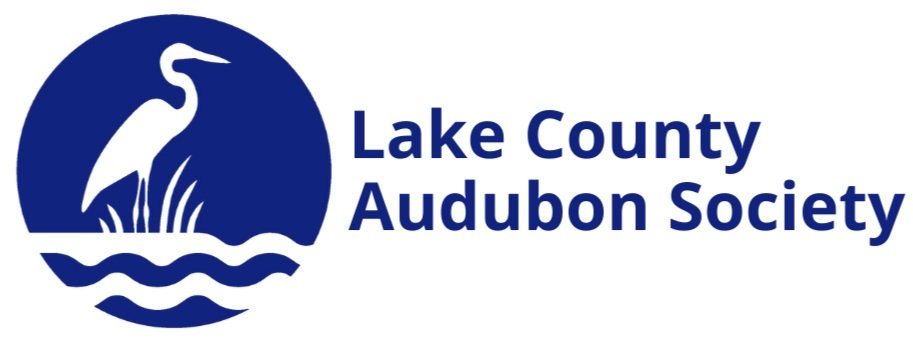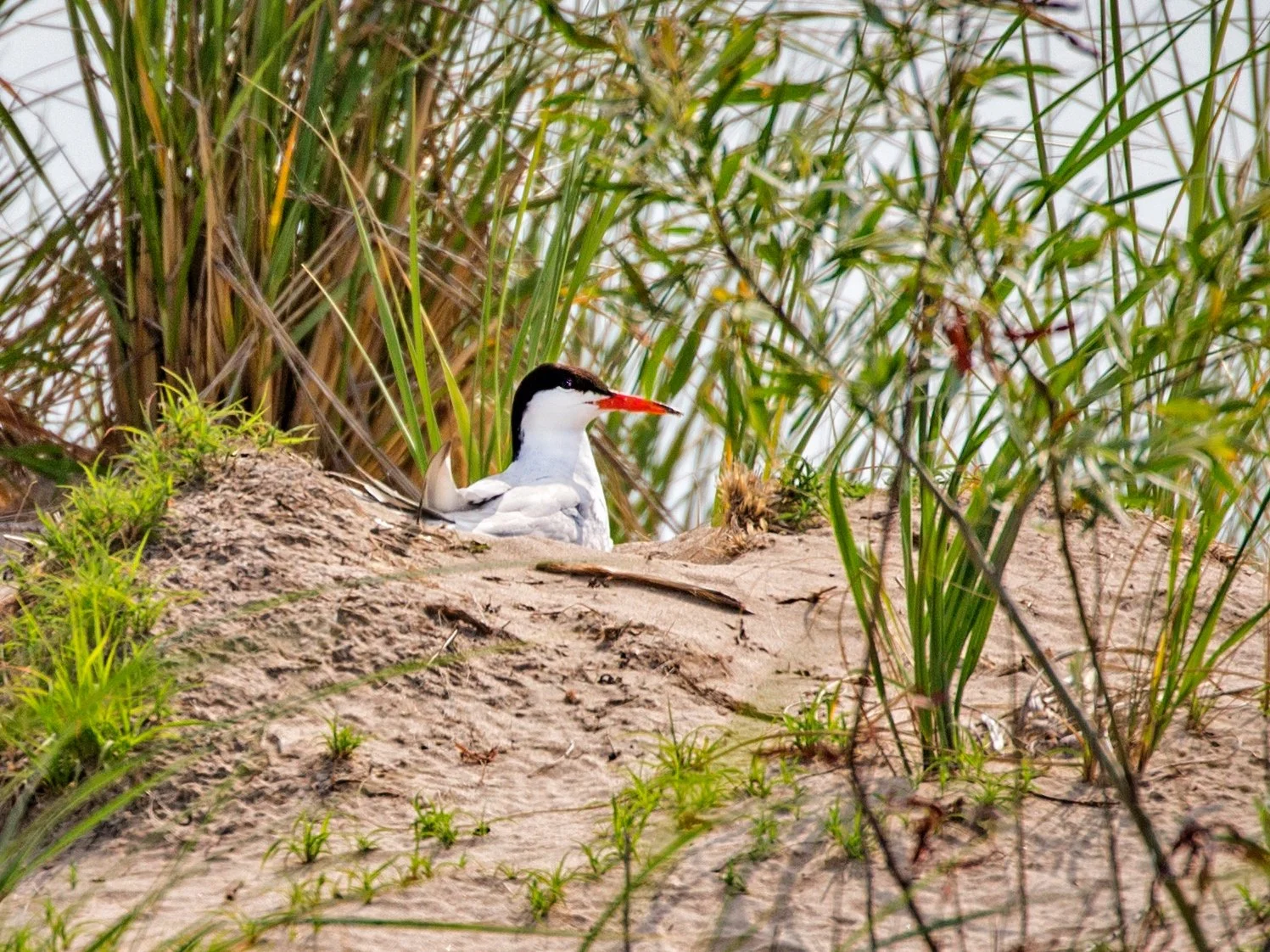Go Birding - Get Outside
Waukegan Beach & Dunes. Photo: Refugio Mariscal
Lake County is a great place to go birding or for a nature walk year-round. Lake County has 37 forest preserves, 3 state parks, numerous local parks, and properties managed by local conservation organizations that make it easy to see birds and experience the wonders of nature close to where we live.
Key Birding Sites in Lake County
Waukegan Lakefront
Common Tern. Photo: Emma England
Due to the diverse habitat of a deep-water harbor, sandy beach, a pocket of trees and a marsh/dune area along Lake Michigan (and despite its busy urban environment), this location has recorded sightings of over 300 species. The main harbor can be viewed from the canoe launch and by walking out several hundred yards on Government Pier. The area is excellent for migrating waterfowl and attracts many ducks/gulls in deep winter when inland lakes are frozen. In addition, wintering birds sometimes feed at the small river outlet out from the south pier. At the swimming beach, you can walk north along the beach to a marshy area where many Marsh & Sedge Wrens and Common Yellowthroats are found. Also nesting at times are both American and Least Bitterns and all the local herons/egrets are common. This is a favored location for shorebirds including sandpipers, plovers, willets, and possible purple sandpiper. The endangered Piping Plovers have attempted nesting at this site and others in migration have been observed. In summer, Caspian Terns can be seen on most days with less frequent sightings of Forster’s and common tern. The small area of trees just north and south of the parking lot is a migrant trap with 32 warbler species sighted over the years! There is a self-guided walk in English and Spanish. Self-Guided Walk for General Public.
Note: There is a fee for parking in the beach area on weekends in the summer.
Location: Waukegan (Northeast Lake County)
Best Time of Year: Year-round
Key Species: Migrating ducks, shorebirds, warblers/vireos, possible Snowy Owls, Peregrine Falcon, Piping Plover, bitterns.
More Information
Illinois Beach State Park and North Point Marina
The 4162-acre state park with 6 miles of sandy beach includes a marina, campground, swimming beach plus the first dedicated Illinois Nature Preserve (which is also a Ramsar wetland site). Illinois Beach State Park has been said to have more plant diversity than any other place in Illinois. There are 40 endangered plant and animal species and more than 650 plant species. Fourteen natural community types are found in the park including dunes, wetlands, prairies, and savanna areas. Within these communities are rare plants such as orchids and cactus. The lake shore is the last remaining undeveloped lake shore in Illinois. The park has been designated as an Important Bird Area. IBSP is home to a variety of marsh birds such as sora rails and sandhill cranes plus much of the shoreline has been designated as critical habitat for the piping plover. The south unit Dead River trail is excellent for spring passerine migration. Great horned owls, red tail hawks, and northern harriers are common in the park. In the summer, whippoorwills can be heard in the evenings. One of the best hawk watches in the Midwest is run from a picnic shelter in the north unit off 17th street. In the winter there are rafts of diving ducks on Lake Michigan, but the North Point Marina harbor is the home of the annual IOS-sponsored Gull Frolic. There is an 8-mile, pea-gravel trail connecting the south unit Nature Center to the north unit Marina which makes for a great birding by bike experience in summer with the cool lake breezes.
Location: Zion (Northeast Lake County)
Best Time of Year: Year-round
Key Species: Migrating fall raptors, spring passerines, migrating shorebirds, wintering ducks.
More Information
Ryerson Conservation Area Lake County Forest Preserve
Black and White Warbler
The 552-acre Preserve offers some of Illinois' most pristine bottomland woodlands plus two small prairie areas and offers 6.5 miles of scenic trails that wind through a deep forest to the quiet Des Plaines River. There are both a nature center and an art center (often with nature-focused exhibits) and two locations with restrooms. One of the top sights in spring for migrants.
Location: Riverwoods (Southeast Lake County)
Best Time of Year: Spring, Fall
Key Species: Spring & Fall Migrants, Warblers, vireos, flycatchers, Pileated & Red-headed Woodpeckers, Barred & Great Horned Owls
More Information
Daniel Wright Woods Lake County Forest Preserve
Pileated Woodpecker. Photo: Doug Reitz
This 750-acre Preserve with 4 miles of trails offers excellent spring birding for migrants. The bridge over the Des Plaines River is a popular area in spring with sightings of up to twenty warbler species such as prothonotary warbler, cerulean warbler, oven birds plus orioles and tanagers. The trails to the southeast out of the parking lot often have red-headed woodpeckers. This preserve also has incredible displays of white trilliums and other spring wildflowers in early May. if you want a longer trail to hike, the preserve is part of the Des Plaines River Trail that connects it to Half Day Forest Preserve (south) and Old School Forest Preserve (north).
Location: Mettawa (Southeast Lake County)
Best Time of Year: Spring, Fall
Key Species: Spring & Fall Migrants, Warblers, vireos, flycatchers, pileated & red-headed woodpeckers, Barred & Great Horned Owls
More Information
Rollins Savanna Lake County Forest Preserve
Rollins Savanna FP. Photo: Refugio Mariscal
With over 1200 acres and 7 miles of trails, this is one of the largest forest preserves and one of the most important prairie/wetland areas for birds. The preserve has extensive, well-maintained prairie plantings and is also a good location for butterflies.
Location: Grayslake (Central Lake County)
Best Time of Year: Summer, Fall
Key Species: Bobolinks, meadowlarks, Sedge & Marsh wrens, Henslow’s & other sparrows, marsh birds, Sandhill Cranes, migrating ducks & swans in fall, possible Short-eared Owls in winter.
More Information
Sedge Meadows Lake County Forest Preserve
This preserve contains restored wetlands and wooded areas along both sides of the Des Plaines River. The trail is outstanding for warblers, vireos, flycatchers, and other spring-migrating passerines. If you only have a short time or prefer to walk only a short distance, park at the canoe launch off Wadsworth Road (east side of the river) and you can see perhaps ten or more warbler species in a ¼ mile walk or perhaps from a sit just off the parking lot area.
Location: Wadsworth (North Central Lake County)
Best Time of Year: Spring, early Summer
Key Species: Spring warblers, vireos, orioles, tanagers, Rose-breasted Grosbeaks, flycatchers
More Information
Independence Grove Lake County Forest Preserve
Blue-gray Gnatcatcher
Although this forest preserve is mainly focused on recreation, the deep-water lake (a former rock quarry) is a prime site for spring/fall migration of grebes, ducks, and loons which can often be at quite a close distance. The preserve features a 3-mile loop along the lake plus a shorter 0.7-mile loop along the north bay and connects across the Des Plaines River to the Casey Trail to the west and to the Des Plaines River Trail to both the south and north. These make for excellent spring and summer birding by bike.
Location: Libertyville (Central Lake County)
Best Time of Year: Spring, Summer, Fall
Key Species: Ducks, grebes, loons, geese in spring and fall, Indigo Buntings, meadowlarks, sparrows, and wrens in summer.
More Information
Birding News
Want to know what others are seeing now? These are some good sources of current birding reports.
eBird
Checklists for county or individual hotspots.
IBET (Illinois Birders Exchanging Thoughts)
Short, written, often entertaining descriptions of local birders’ current sightings.
Facebook
Illinois Birding Network Facebook Group.
Birding Apps
Leave your heavy field guidebook at home and use any/all of these phone apps!
eBird
Record all your sightings for your own enjoyment of your progress in birding and to support ornithological research. The new Explore feature in the mobile app shows you all the local hotspots on a map of the county, with directions and a list of the most recent sightings. Global coverage.
Merlin
Photo-based. Can select a given hotspot for a given date anywhere across the globe and either see photos of all or most likely birds with a frequency bar chart (is this a common bird or rare for this date?), range map, vocalizations, and short description. Extremely helpful for beginning birders as it narrows the field guide down to just birds you would expect to see for that hotspot. Global coverage.
Audubon
Photo-based. Field guide which can be sorted by state and date but not specific to hotspots like Merlin. Excellent detailed description. Lengthy description and range maps were provided but no frequency bar charts. The New Explore feature shows a list with thumbnail pic of sightings in the most recent order for local hotspots. U.S. coverage only.
Raptor ID
Photo-Based. Excellent photos/videos of raptors in flight. Detailed description. U.S. coverage only.
Sibley
Drawing-Based. Ready to take your game up a notch? Considered the top US field guide by most birders. Detailed drawings & description with field marks for ID. Vocalizations, range maps. U.S. coverage only.
Birding Organizations
-
This is the parent organization for Lake County Audubon Society. This organization is an advocate for bird conservation and public policy support throughout the U.S. and supports Audubon nature centers in many states. Members of the National Audubon Society receive a monthly magazine.
-
This is a separate organization from the National Audubon Society and supports bird conservation in Illinois and manages their own 16 nature sanctuaries outside the Chicagoland area. They run monthly field trips across the state (Prairie chicken viewing on lek!) and a fun annual weekend/conference with 10 – 20 field trips, programs, and group meals/hotel accommodation at different locations each year around Illinois.
-
This affiliate of Illinois Audubon Society promotes appreciation and increase knowledge of wild birdlife and the environment that supports it, and to further the conservation of natural resources in McHenry. They host monthly programs and member-led field trips in McHenry County.
-
This is the local chapter of the Illinois Audubon Society. The organization supports monthly programs on bird conservation and birding in Illinois and around the globe. The organization typically runs about 20 – 30 field trips each year, many led by the top local birders.







